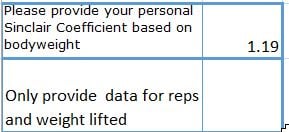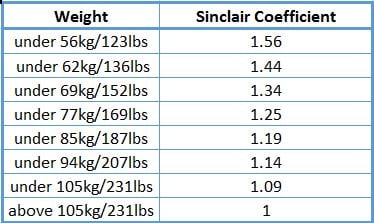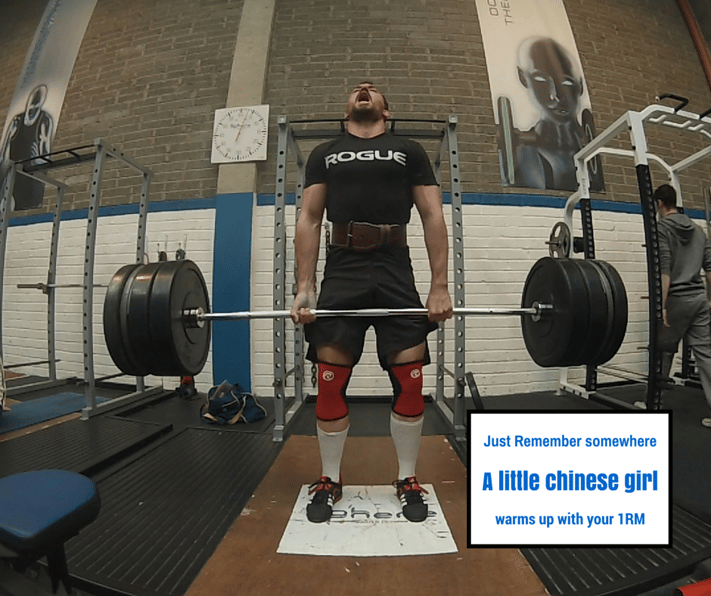Deadlift Calculator
If you want to master the mighty deadlift, you better track if you are taming the beast. Step up to the plate, pull more than your own weight and look how you progress. All supported by this free excel calculator to save you some time.
Intro
This calculator was designed to help you to track your progression on the mighty deadlift. My personal favorite of the three big lifts it is most likely the one lift on which you will move the most weight, as you can activate your legs and your upper body in the lift.
Main thing about the Deaqdlift is keeping a neutral spine as long as you can. This is mainly tied to your setup and how you begin the lift. Layne Norton's workshop on bodybuilding.com is a very good source to start with proper technique.
The higher you go in load, the more likely it will become that your form will break down, but if you are rounding your back on the warm up sets, like I used to do, you are definetly training with a flaw.
If you want to progress on the deadlift check out Stronglifts 5x5 or 531. Both programs which helped me to progress to higher loads continously.
The calculator is for free and all cells can be amended, if you so may wish. I put two years of lifting experience into it and tried to keep it as simple as possible to use without any fluff, as I found that lifters are quite a pragmatic bunch of poeple.
If you have any questions, ideas for improvement or other general comments please pop them below. I am always open to learn and improve.
Other calculators
There are other calculators out there and if you just want to quickly calculate what your one repetition maximum is, maybe other calculators will meet your need quicker.
However if you found an offline tracker, which will track your deadlift progression over a longer period, is not tied into an overall program and let's you use it flexibly with any program you are on incorporating the deadlift, this is the place to go.
Usually other calculators around are embedded on a bigger spreadsheet or you have to come back to the specific website it is on every single time you want to recalculate your 1RM. Also seldomly they provide your lifting history, unless you upgrade and pay or get an account with them.
Repetitions

In this column you will provide the amount of repetitions that you have done for the deadlift. Some notes here on different versions of the deadlift and I would recommend to be consistent with one of these variations to get the most insight of your progression. The more you change grip / bars on your top sets, the harder it will get to track your progression in a fair manner. In the following descriptions I will not go into full depth of Deadlift setup, but make yourself fmiliar with it to avoid injury either on my blog or in secondary sources.
Double overhand grip deadlift
The double overhand grip is usually the grip beginners start out with. Here you will grip the bar with both hands slightly outwards your legs. Your legs should be roughly shoulder width apart, while the feet are slightly pointing outwards. You will then place the hands on the bar, get your spine in neutral position and initiate the pull.
Over under grip
As the name states the usually dominant of the lifter will be in overhand grip position and the other will be wrapped beneath the barbell. This will provide you with more grip strength for your maximum effort lifts. This is cause by the bar rolling out of one hand and into the other if your grip weakens. As this technique can lead to asymmetries in alifter if overdone, please take care that only your top sets are done in this way. At least that works for me.
Hook grip
The hook grip is mianly utilised in olympic weightlifting, but also has a carry over to powerlifting and to the deadlift. With the hook grip you lock in your thumb by wrapping it around the barbell and then closing in on out with your other fingers.
This technique is painful at the beginning and I would not recommend it for beginning lifters, but if you want to become one hell of a beast on the deadlift, the hook grip has to be in your repertoire.
Trap bar deadlifts
This form of deadlift is done with a trap bar. Here the lifter can stand inside the frame of the trap bar. This usually leads to more weight pulled and less strain during the lift, as it is technically less challenging. As the trap bar is not used in any weightlifting or powerlifting competitions, it can only by a supportive tool if you intend to compete.
Depending on which form of deadlift you will pick provide your results for your top set in the repetition column of the calculator.
Weight

The second variable is the weight that you have pulled. Here it does not matter whether you provide it in pounds or kilograms for this calculator to work. Count up the weight including the barbell and punch it in the field to see the rest of calculator populate with information.
A standard barbell usually weighs 20kg / 45 pounds and are included in any calculations that are being done. Trap Bars usually come in a boit heavier around 30kgs as they are sturdier than regular barbells. If you are using a mastodon bar for your deadlifts you would have to calculate with 30kg also. However that is unlikely, as these are only used by the most elite lifters in the world. If you are struggling to pick the weight, as you are just starting out, here are some rules of thumbs which I find to be helpful:
10 repetitions = Use 40% - 60% of your one repetition maximum
5 repetitions = Use 60% - 85% of 1RM
1 - 3 repetitions = Use 75% to 95%
If you currently have no clue how many repetitions to do and which weight to pick, please refer to some pre written programs which you can find on the internet at least, even better have a chat with your local gym instructor based on your goals.
One repetition maximum

These fields will autopopulate as soon as you have provided weight and repetitions. The underlying formula is provided in the worksheet for transparency, so that you know have your 1RM is calculated.
Always keep in mind that calculated one repetitions maximums are a good indicator whether you are progressing or not on your program. These numbers do not mean that you can actually lift the weight. The only way to know is to test this. I would always advise caution with loads you have never lifted before and take a conservative approach rather than over optimistic approach based on your calculated maxes, when you test.
You can always add another 2.5kg and reattempt. A pulled hamstring on the other hand will put you out of business for quite a while. Please leave your ego at home and train smart.
Sinclair Coefficient


As we are talking of ego a few words on the Sinclair coefficient which I provided for you also in this worksheet. The sinclair coeeficient has been developed to compare lifters from different weight classes in a fair manner.
The big guys wilusually make a calim for that the ultimate test of strength is how much you have lifted overall, whereas the smaller guys will argue, that how much you lift per kg of bodyweight is the ultimate measuring stick of power.
You can either keep arguing that point until infinity or introduce some maths to make everything even and comparable. The sinclair coefficient does exactly that. Please provide your own coefficient based on your bodyweight before using the calculator, to invidualise it to yourself.
Dynamic

This weight will provide your load for warm up sets or dymanic work. This is usually put at 50% of your 1RM and id calculated in the same way in this worksheet for you. No thinking required ;).
Advanced Techniques
If you want to push your deadlift to the next level you might want to use bands and chains in your training. Another option, if oyu had about 200€ to spare, is to look into velocity based training. Here focus is put more on how quick you are moving the bar under a specific load and training is adjusted accordingly. If yu don't have 200€ to spare, go for this free template.
Own experience
The deadlift has more to do with technique as might probably think. Usually the setup will already determine whether you will be successful or not. I personally made a lot of gains (15kg in two weeks) by only adjusting my setup and getting tighter at the start. Especially when you start out be wiser than me and emphasize technique over weight increases. It will pay off in the long run, as you do not have to relearn the lift.
Conclusion
This calculator will help you to make a start on your deadlift, especially when it is stand alone / not embedded in a wider program. I hope you'll find the content useful to reach your own goals.


